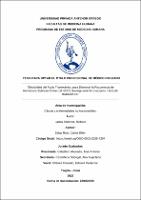| dc.contributor.advisor | Salas Ruiz, Carlos Efrén | |
| dc.contributor.author | Landa Sánchez, Rebeca | |
| dc.creator | Landa Sánchez, Rebeca | |
| dc.date.accessioned | 2023-04-03T22:31:05Z | |
| dc.date.available | 2023-04-03T22:31:05Z | |
| dc.date.issued | 2023 | |
| dc.identifier.uri | https://hdl.handle.net/20.500.12759/10553 | |
| dc.description.abstract | Determinar la efectividad del Ácido Tranexámico para disminuir la
recurrencia de Hematoma Subdural Crónico quirúrgicamente evacuado en
pacientes del área de neurocirugía del Hospital Regional Docente de Trujillo y
la Clínica Peruano Americana durante el periodo 2019 – 2020.
Material y métodos: Se llevó a cabo un estudio analítico, de cohorte
prospectivo en el cual se incluyeron 62 pacientes con diagnóstico de hematoma
subdural crónico (HSDC), según los criterios de selección establecidos, dichos
pacientes se dividieron en función a si fueron expuestos o no al tratamiento con
ácido tranexámico.
Resultados: Se determinó que un 9.7% de recurrencia de hematoma subdural
crónico en pacientes que recibieron ácido tranexámico y un 74.2% de
recurrencia de hematoma subdural crónico en pacientes que no recibieron
ácido tranexámico, con un valor p de 0.001 (p < 0.05). Se determinó que el
16.1% de pacientes que recibieron tratamiento con ácido tranexámico
presentaron complicaciones postquirúrgicas, mientras que el 67.7% de los
pacientes que no recibieron tratamiento con ácido tranexámico presentaron
complicaciones postquirúrgicas; con un valor p de 0.001 (p < 0.05). No se
encontró una diferencia significativa en los puntajes de la escala GOSE, tanto
en los pacientes que recibieron y no recibieron ácido tranexámico, con un valor
p de 0.652 (p > 0.05).
Conclusión: El Ácido Tranexámico tiene efectividad para disminuir la
recurrencia de Hematoma Subdural Crónico quirúrgicamente evacuado y
disminuir las complicaciones post quirúrgicas en pacientes del Hospital
Regional Docente de Trujillo y la Clínica Peruano Americana. | es_PE |
| dc.description.abstract | Determine the effectiveness of Tranexamic Acid to reduce the
recurrence of surgically evacuated chronic subdural haematoma in patients of
the neurosurgery area of the Hospital Regional Docente de Trujillo and the
Clínica Peruano Americana during the period 2019 - 2020.
Material and methods: An analytical, prospective cohort study was carried out
in which 62 patients with a diagnosis of chronic subdural hematoma (CSDH)
were included, according to the established selection criteria. These patients
were divided into 2 study groups according to whether or not they were exposed
to tranexamic acid treatment.
Results: Recurrence of chronic subdural hematoma was found to be 9.7% in
patients who received tranexamic acid and 74.2% in patients who did not
receive tranexamic acid, with a p-value < 0.001 (p < 0.05). Post-surgical
complications were determined in 16.1% of patients who received tranexamic
acid treatment, while 67.7% of patients who did not receive tranexamic acid
treatment had post-surgical complications; with a p-value < 0.001 (p < 0.05).
There was no significant difference in the GOSE scale scores, whether patients
did or did not receive tranexamic acid, with a p-value of 0.652 (p > 0.05).
Conclusion: Tranexamic acid is effective in reducing the recurrence of
surgically evacuated chronic subdural haematoma in patients of the Hospital
Regional Docente de Trujillo and the Clinica Peruano Americana. | en_US |
| dc.description.uri | Tesis | es_PE |
| dc.format | application/pdf | es_PE |
| dc.language.iso | spa | es_PE |
| dc.publisher | Universidad Privada Antenor Orrego | es_PE |
| dc.relation.ispartofseries | T_MED_3396 | |
| dc.rights | info:eu-repo/semantics/openAccess | es_PE |
| dc.rights.uri | https://creativecommons.org/licenses/by/4.0/ | es_PE |
| dc.source | Universidad Privada Antenor Orrego | es_PE |
| dc.source | Repositorio Institucional - UPAO | es_PE |
| dc.subject | Ácido Tranexámico | es_PE |
| dc.subject | Efectividad | es_PE |
| dc.title | Efectividad del Ácido Tranexámico para Disminuir la Recurrencia de Hematoma Subdural Crónico (HSDC) Quirúrgicamente Evacuado – Estudio Multicéntrico | es_PE |
| dc.type | info:eu-repo/semantics/bachelorThesis | es_PE |
| thesis.degree.level | Título Profesional | es_PE |
| thesis.degree.grantor | Universidad Privada Antenor Orrego. Facultad de Medicina Humana | es_PE |
| thesis.degree.name | Médico Cirujano | es_PE |
| thesis.degree.discipline | Medicina Humana | es_PE |
| dc.subject.ocde | https://purl.org/pe-repo/ocde/ford#3.02.27 | es_PE |
| renati.advisor.orcid | https://orcid.org/0000-0002-2525-7297 | es_PE |
| renati.author.dni | 72327099 | |
| renati.advisor.dni | 17843851 | |
| renati.type | https://purl.org/pe-repo/renati/type#tesis | es_PE |
| renati.level | https://purl.org/pe-repo/renati/level#tituloProfesional | es_PE |
| renati.discipline | 912016 | es_PE |
| renati.juror | Caballero Alvarado, José Antonio | |
| renati.juror | Castañeda Sabogal, Alex Napoleón | |
| renati.juror | Chávez Cruzado, Edward Valdemar | |
| dc.publisher.country | PE | es_PE |


